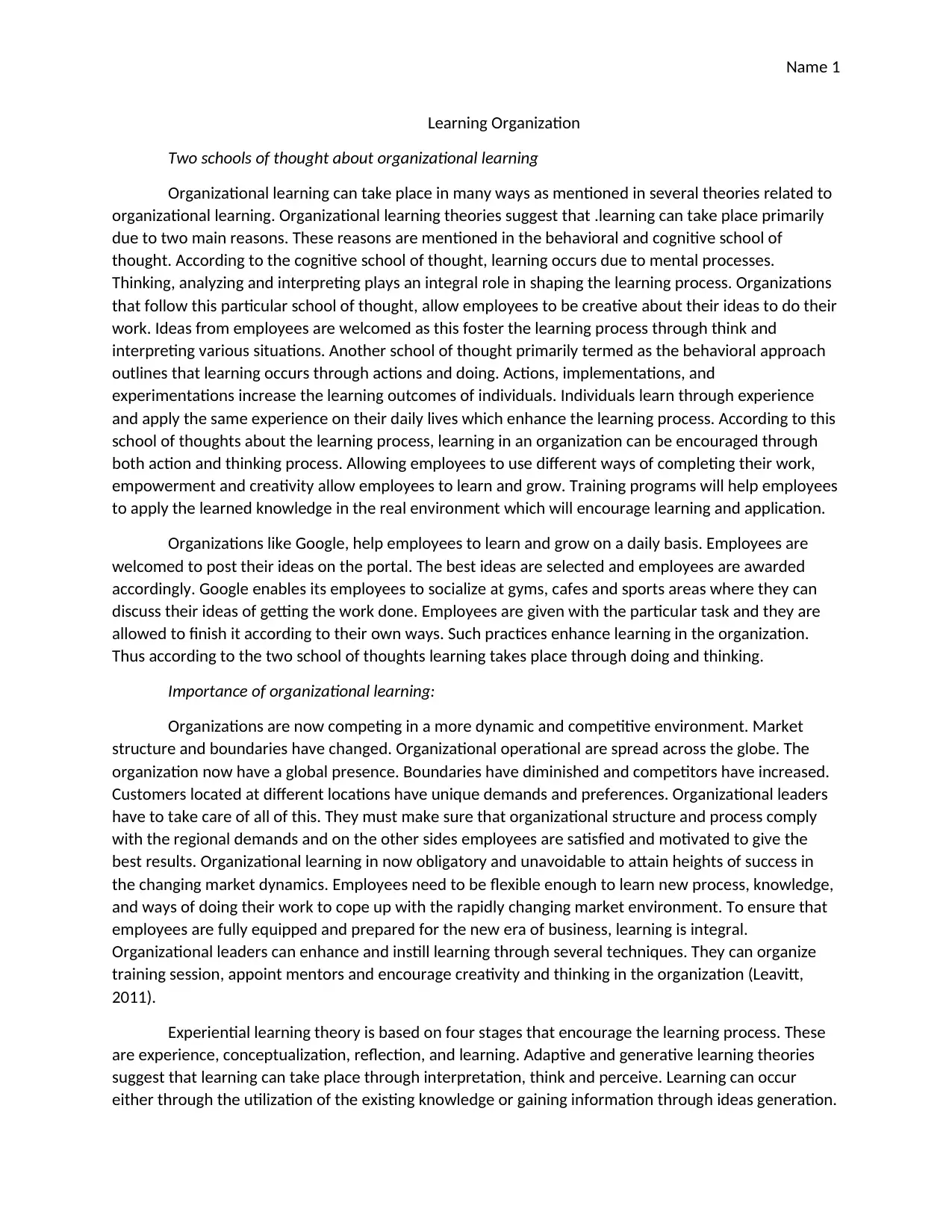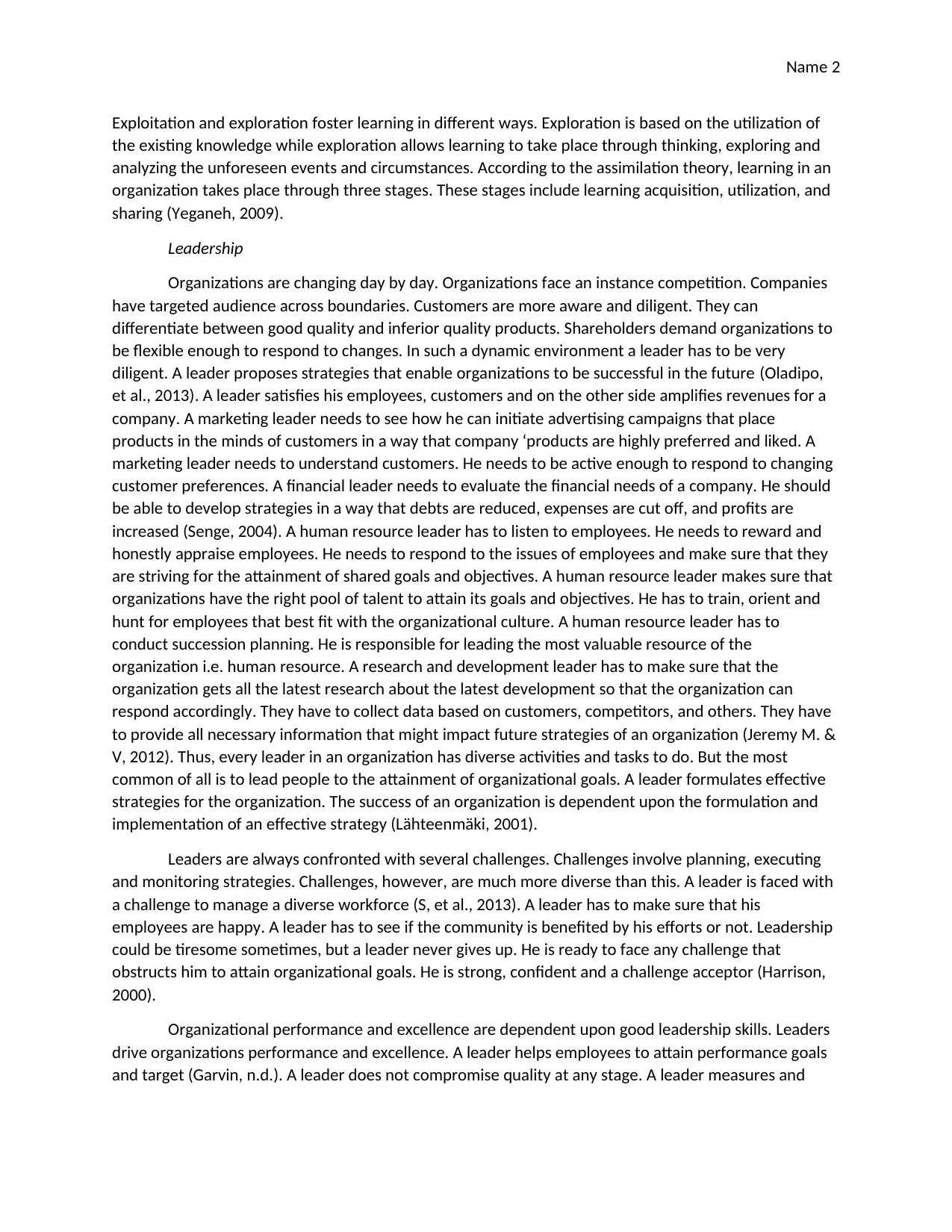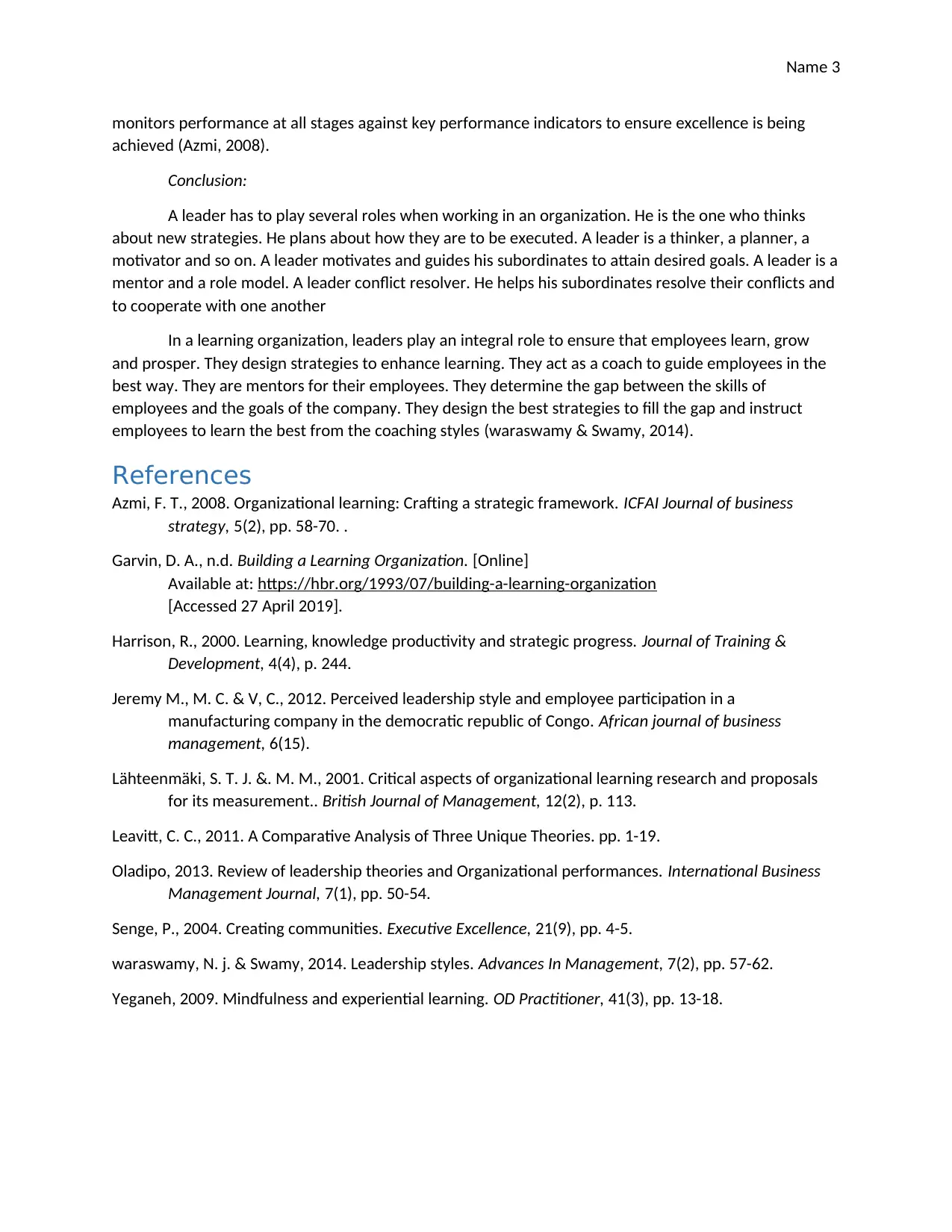Organizational Learning, Leadership, and Performance Report
VerifiedAdded on 2022/12/01
|4
|1775
|289
Report
AI Summary
This report delves into the critical aspects of organizational learning and leadership, examining how these elements contribute to organizational success. It explores two primary schools of thought on organizational learning: the cognitive approach, which emphasizes mental processes, and the behavioral approach, which highlights learning through actions and experiences. The report underscores the importance of organizational learning in today's dynamic business environment, emphasizing the need for employees to adapt to rapid market changes. It also discusses various leadership styles and their roles in fostering learning environments, including the challenges leaders face and the strategies they employ. The report covers theories like experiential, adaptive, and generative learning, along with the assimilation theory, and concludes by highlighting the leader's role in motivating, guiding, and resolving conflicts within a learning organization. The report references several scholarly articles to support its arguments, providing a comprehensive overview of the subject.

Name 1
Learning Organization
Two schools of thought about organizational learning
Organizational learning can take place in many ways as mentioned in several theories related to
organizational learning. Organizational learning theories suggest that .learning can take place primarily
due to two main reasons. These reasons are mentioned in the behavioral and cognitive school of
thought. According to the cognitive school of thought, learning occurs due to mental processes.
Thinking, analyzing and interpreting plays an integral role in shaping the learning process. Organizations
that follow this particular school of thought, allow employees to be creative about their ideas to do their
work. Ideas from employees are welcomed as this foster the learning process through think and
interpreting various situations. Another school of thought primarily termed as the behavioral approach
outlines that learning occurs through actions and doing. Actions, implementations, and
experimentations increase the learning outcomes of individuals. Individuals learn through experience
and apply the same experience on their daily lives which enhance the learning process. According to this
school of thoughts about the learning process, learning in an organization can be encouraged through
both action and thinking process. Allowing employees to use different ways of completing their work,
empowerment and creativity allow employees to learn and grow. Training programs will help employees
to apply the learned knowledge in the real environment which will encourage learning and application.
Organizations like Google, help employees to learn and grow on a daily basis. Employees are
welcomed to post their ideas on the portal. The best ideas are selected and employees are awarded
accordingly. Google enables its employees to socialize at gyms, cafes and sports areas where they can
discuss their ideas of getting the work done. Employees are given with the particular task and they are
allowed to finish it according to their own ways. Such practices enhance learning in the organization.
Thus according to the two school of thoughts learning takes place through doing and thinking.
Importance of organizational learning:
Organizations are now competing in a more dynamic and competitive environment. Market
structure and boundaries have changed. Organizational operational are spread across the globe. The
organization now have a global presence. Boundaries have diminished and competitors have increased.
Customers located at different locations have unique demands and preferences. Organizational leaders
have to take care of all of this. They must make sure that organizational structure and process comply
with the regional demands and on the other sides employees are satisfied and motivated to give the
best results. Organizational learning in now obligatory and unavoidable to attain heights of success in
the changing market dynamics. Employees need to be flexible enough to learn new process, knowledge,
and ways of doing their work to cope up with the rapidly changing market environment. To ensure that
employees are fully equipped and prepared for the new era of business, learning is integral.
Organizational leaders can enhance and instill learning through several techniques. They can organize
training session, appoint mentors and encourage creativity and thinking in the organization (Leavitt,
2011).
Experiential learning theory is based on four stages that encourage the learning process. These
are experience, conceptualization, reflection, and learning. Adaptive and generative learning theories
suggest that learning can take place through interpretation, think and perceive. Learning can occur
either through the utilization of the existing knowledge or gaining information through ideas generation.
Learning Organization
Two schools of thought about organizational learning
Organizational learning can take place in many ways as mentioned in several theories related to
organizational learning. Organizational learning theories suggest that .learning can take place primarily
due to two main reasons. These reasons are mentioned in the behavioral and cognitive school of
thought. According to the cognitive school of thought, learning occurs due to mental processes.
Thinking, analyzing and interpreting plays an integral role in shaping the learning process. Organizations
that follow this particular school of thought, allow employees to be creative about their ideas to do their
work. Ideas from employees are welcomed as this foster the learning process through think and
interpreting various situations. Another school of thought primarily termed as the behavioral approach
outlines that learning occurs through actions and doing. Actions, implementations, and
experimentations increase the learning outcomes of individuals. Individuals learn through experience
and apply the same experience on their daily lives which enhance the learning process. According to this
school of thoughts about the learning process, learning in an organization can be encouraged through
both action and thinking process. Allowing employees to use different ways of completing their work,
empowerment and creativity allow employees to learn and grow. Training programs will help employees
to apply the learned knowledge in the real environment which will encourage learning and application.
Organizations like Google, help employees to learn and grow on a daily basis. Employees are
welcomed to post their ideas on the portal. The best ideas are selected and employees are awarded
accordingly. Google enables its employees to socialize at gyms, cafes and sports areas where they can
discuss their ideas of getting the work done. Employees are given with the particular task and they are
allowed to finish it according to their own ways. Such practices enhance learning in the organization.
Thus according to the two school of thoughts learning takes place through doing and thinking.
Importance of organizational learning:
Organizations are now competing in a more dynamic and competitive environment. Market
structure and boundaries have changed. Organizational operational are spread across the globe. The
organization now have a global presence. Boundaries have diminished and competitors have increased.
Customers located at different locations have unique demands and preferences. Organizational leaders
have to take care of all of this. They must make sure that organizational structure and process comply
with the regional demands and on the other sides employees are satisfied and motivated to give the
best results. Organizational learning in now obligatory and unavoidable to attain heights of success in
the changing market dynamics. Employees need to be flexible enough to learn new process, knowledge,
and ways of doing their work to cope up with the rapidly changing market environment. To ensure that
employees are fully equipped and prepared for the new era of business, learning is integral.
Organizational leaders can enhance and instill learning through several techniques. They can organize
training session, appoint mentors and encourage creativity and thinking in the organization (Leavitt,
2011).
Experiential learning theory is based on four stages that encourage the learning process. These
are experience, conceptualization, reflection, and learning. Adaptive and generative learning theories
suggest that learning can take place through interpretation, think and perceive. Learning can occur
either through the utilization of the existing knowledge or gaining information through ideas generation.
Paraphrase This Document
Need a fresh take? Get an instant paraphrase of this document with our AI Paraphraser

Name 2
Exploitation and exploration foster learning in different ways. Exploration is based on the utilization of
the existing knowledge while exploration allows learning to take place through thinking, exploring and
analyzing the unforeseen events and circumstances. According to the assimilation theory, learning in an
organization takes place through three stages. These stages include learning acquisition, utilization, and
sharing (Yeganeh, 2009).
Leadership
Organizations are changing day by day. Organizations face an instance competition. Companies
have targeted audience across boundaries. Customers are more aware and diligent. They can
differentiate between good quality and inferior quality products. Shareholders demand organizations to
be flexible enough to respond to changes. In such a dynamic environment a leader has to be very
diligent. A leader proposes strategies that enable organizations to be successful in the future (Oladipo,
et al., 2013). A leader satisfies his employees, customers and on the other side amplifies revenues for a
company. A marketing leader needs to see how he can initiate advertising campaigns that place
products in the minds of customers in a way that company ‘products are highly preferred and liked. A
marketing leader needs to understand customers. He needs to be active enough to respond to changing
customer preferences. A financial leader needs to evaluate the financial needs of a company. He should
be able to develop strategies in a way that debts are reduced, expenses are cut off, and profits are
increased (Senge, 2004). A human resource leader has to listen to employees. He needs to reward and
honestly appraise employees. He needs to respond to the issues of employees and make sure that they
are striving for the attainment of shared goals and objectives. A human resource leader makes sure that
organizations have the right pool of talent to attain its goals and objectives. He has to train, orient and
hunt for employees that best fit with the organizational culture. A human resource leader has to
conduct succession planning. He is responsible for leading the most valuable resource of the
organization i.e. human resource. A research and development leader has to make sure that the
organization gets all the latest research about the latest development so that the organization can
respond accordingly. They have to collect data based on customers, competitors, and others. They have
to provide all necessary information that might impact future strategies of an organization (Jeremy M. &
V, 2012). Thus, every leader in an organization has diverse activities and tasks to do. But the most
common of all is to lead people to the attainment of organizational goals. A leader formulates effective
strategies for the organization. The success of an organization is dependent upon the formulation and
implementation of an effective strategy (Lähteenmäki, 2001).
Leaders are always confronted with several challenges. Challenges involve planning, executing
and monitoring strategies. Challenges, however, are much more diverse than this. A leader is faced with
a challenge to manage a diverse workforce (S, et al., 2013). A leader has to make sure that his
employees are happy. A leader has to see if the community is benefited by his efforts or not. Leadership
could be tiresome sometimes, but a leader never gives up. He is ready to face any challenge that
obstructs him to attain organizational goals. He is strong, confident and a challenge acceptor (Harrison,
2000).
Organizational performance and excellence are dependent upon good leadership skills. Leaders
drive organizations performance and excellence. A leader helps employees to attain performance goals
and target (Garvin, n.d.). A leader does not compromise quality at any stage. A leader measures and
Exploitation and exploration foster learning in different ways. Exploration is based on the utilization of
the existing knowledge while exploration allows learning to take place through thinking, exploring and
analyzing the unforeseen events and circumstances. According to the assimilation theory, learning in an
organization takes place through three stages. These stages include learning acquisition, utilization, and
sharing (Yeganeh, 2009).
Leadership
Organizations are changing day by day. Organizations face an instance competition. Companies
have targeted audience across boundaries. Customers are more aware and diligent. They can
differentiate between good quality and inferior quality products. Shareholders demand organizations to
be flexible enough to respond to changes. In such a dynamic environment a leader has to be very
diligent. A leader proposes strategies that enable organizations to be successful in the future (Oladipo,
et al., 2013). A leader satisfies his employees, customers and on the other side amplifies revenues for a
company. A marketing leader needs to see how he can initiate advertising campaigns that place
products in the minds of customers in a way that company ‘products are highly preferred and liked. A
marketing leader needs to understand customers. He needs to be active enough to respond to changing
customer preferences. A financial leader needs to evaluate the financial needs of a company. He should
be able to develop strategies in a way that debts are reduced, expenses are cut off, and profits are
increased (Senge, 2004). A human resource leader has to listen to employees. He needs to reward and
honestly appraise employees. He needs to respond to the issues of employees and make sure that they
are striving for the attainment of shared goals and objectives. A human resource leader makes sure that
organizations have the right pool of talent to attain its goals and objectives. He has to train, orient and
hunt for employees that best fit with the organizational culture. A human resource leader has to
conduct succession planning. He is responsible for leading the most valuable resource of the
organization i.e. human resource. A research and development leader has to make sure that the
organization gets all the latest research about the latest development so that the organization can
respond accordingly. They have to collect data based on customers, competitors, and others. They have
to provide all necessary information that might impact future strategies of an organization (Jeremy M. &
V, 2012). Thus, every leader in an organization has diverse activities and tasks to do. But the most
common of all is to lead people to the attainment of organizational goals. A leader formulates effective
strategies for the organization. The success of an organization is dependent upon the formulation and
implementation of an effective strategy (Lähteenmäki, 2001).
Leaders are always confronted with several challenges. Challenges involve planning, executing
and monitoring strategies. Challenges, however, are much more diverse than this. A leader is faced with
a challenge to manage a diverse workforce (S, et al., 2013). A leader has to make sure that his
employees are happy. A leader has to see if the community is benefited by his efforts or not. Leadership
could be tiresome sometimes, but a leader never gives up. He is ready to face any challenge that
obstructs him to attain organizational goals. He is strong, confident and a challenge acceptor (Harrison,
2000).
Organizational performance and excellence are dependent upon good leadership skills. Leaders
drive organizations performance and excellence. A leader helps employees to attain performance goals
and target (Garvin, n.d.). A leader does not compromise quality at any stage. A leader measures and

Name 3
monitors performance at all stages against key performance indicators to ensure excellence is being
achieved (Azmi, 2008).
Conclusion:
A leader has to play several roles when working in an organization. He is the one who thinks
about new strategies. He plans about how they are to be executed. A leader is a thinker, a planner, a
motivator and so on. A leader motivates and guides his subordinates to attain desired goals. A leader is a
mentor and a role model. A leader conflict resolver. He helps his subordinates resolve their conflicts and
to cooperate with one another
In a learning organization, leaders play an integral role to ensure that employees learn, grow
and prosper. They design strategies to enhance learning. They act as a coach to guide employees in the
best way. They are mentors for their employees. They determine the gap between the skills of
employees and the goals of the company. They design the best strategies to fill the gap and instruct
employees to learn the best from the coaching styles (waraswamy & Swamy, 2014).
References
Azmi, F. T., 2008. Organizational learning: Crafting a strategic framework. ICFAI Journal of business
strategy, 5(2), pp. 58-70. .
Garvin, D. A., n.d. Building a Learning Organization. [Online]
Available at: https://hbr.org/1993/07/building-a-learning-organization
[Accessed 27 April 2019].
Harrison, R., 2000. Learning, knowledge productivity and strategic progress. Journal of Training &
Development, 4(4), p. 244.
Jeremy M., M. C. & V, C., 2012. Perceived leadership style and employee participation in a
manufacturing company in the democratic republic of Congo. African journal of business
management, 6(15).
Lähteenmäki, S. T. J. &. M. M., 2001. Critical aspects of organizational learning research and proposals
for its measurement.. British Journal of Management, 12(2), p. 113.
Leavitt, C. C., 2011. A Comparative Analysis of Three Unique Theories. pp. 1-19.
Oladipo, 2013. Review of leadership theories and Organizational performances. International Business
Management Journal, 7(1), pp. 50-54.
Senge, P., 2004. Creating communities. Executive Excellence, 21(9), pp. 4-5.
waraswamy, N. j. & Swamy, 2014. Leadership styles. Advances In Management, 7(2), pp. 57-62.
Yeganeh, 2009. Mindfulness and experiential learning. OD Practitioner, 41(3), pp. 13-18.
monitors performance at all stages against key performance indicators to ensure excellence is being
achieved (Azmi, 2008).
Conclusion:
A leader has to play several roles when working in an organization. He is the one who thinks
about new strategies. He plans about how they are to be executed. A leader is a thinker, a planner, a
motivator and so on. A leader motivates and guides his subordinates to attain desired goals. A leader is a
mentor and a role model. A leader conflict resolver. He helps his subordinates resolve their conflicts and
to cooperate with one another
In a learning organization, leaders play an integral role to ensure that employees learn, grow
and prosper. They design strategies to enhance learning. They act as a coach to guide employees in the
best way. They are mentors for their employees. They determine the gap between the skills of
employees and the goals of the company. They design the best strategies to fill the gap and instruct
employees to learn the best from the coaching styles (waraswamy & Swamy, 2014).
References
Azmi, F. T., 2008. Organizational learning: Crafting a strategic framework. ICFAI Journal of business
strategy, 5(2), pp. 58-70. .
Garvin, D. A., n.d. Building a Learning Organization. [Online]
Available at: https://hbr.org/1993/07/building-a-learning-organization
[Accessed 27 April 2019].
Harrison, R., 2000. Learning, knowledge productivity and strategic progress. Journal of Training &
Development, 4(4), p. 244.
Jeremy M., M. C. & V, C., 2012. Perceived leadership style and employee participation in a
manufacturing company in the democratic republic of Congo. African journal of business
management, 6(15).
Lähteenmäki, S. T. J. &. M. M., 2001. Critical aspects of organizational learning research and proposals
for its measurement.. British Journal of Management, 12(2), p. 113.
Leavitt, C. C., 2011. A Comparative Analysis of Three Unique Theories. pp. 1-19.
Oladipo, 2013. Review of leadership theories and Organizational performances. International Business
Management Journal, 7(1), pp. 50-54.
Senge, P., 2004. Creating communities. Executive Excellence, 21(9), pp. 4-5.
waraswamy, N. j. & Swamy, 2014. Leadership styles. Advances In Management, 7(2), pp. 57-62.
Yeganeh, 2009. Mindfulness and experiential learning. OD Practitioner, 41(3), pp. 13-18.
⊘ This is a preview!⊘
Do you want full access?
Subscribe today to unlock all pages.

Trusted by 1+ million students worldwide

Name 4
1 out of 4
Related Documents
Your All-in-One AI-Powered Toolkit for Academic Success.
+13062052269
info@desklib.com
Available 24*7 on WhatsApp / Email
![[object Object]](/_next/static/media/star-bottom.7253800d.svg)
Unlock your academic potential
Copyright © 2020–2025 A2Z Services. All Rights Reserved. Developed and managed by ZUCOL.



